Victoria, MS Map & Demographics
Victoria Overview
$59,065
PER CAPITA INCOME
$92,930
AVG HOUSEHOLD INCOME
0.54
INEQUALITY / GINI INDEX
1,245
TOTAL POPULATION
668
MALE POPULATION
577
FEMALE POPULATION
115.77
MALES / 100 FEMALES
86.38
FEMALES / 100 MALES
47.0
MEDIAN AGE
2.7
AVG FAMILY SIZE
2.1
AVG HOUSEHOLD SIZE
667
LABOR FORCE [ PEOPLE ]
58.5%
PERCENT IN LABOR FORCE
Victoria Area Codes
Income in Victoria
Income Overview in Victoria
| Characteristic | Number | Measure |
| Per Capita Income | 1,245 | $59,065 |
| Median Family Income | 320 | $0 |
| Mean Family Income | 320 | $127,531 |
| Median Household Income | 593 | $92,930 |
| Mean Household Income | 593 | $132,527 |
| Income Deficit | 320 | $0 |
| Wage / Income Gap (%) | 1,245 | 0.00% |
| Wage / Income Gap ($) | 1,245 | 100.00¢ per $1 |
| Gini / Inequality Index | 1,245 | 0.54 |
Earnings by Sex in Victoria

| Sex | Number | Average Earnings |
| Male | 522 (75.1%) | $66,987 |
| Female | 173 (24.9%) | $0 |
| Total | 695 (100.0%) | $66,186 |
Earnings by Sex by Income Bracket in Victoria
The most common earnings brackets in Victoria are $75,000 to $99,999 for men (145 | 27.8%) and $75,000 to $99,999 for women (74 | 42.8%).
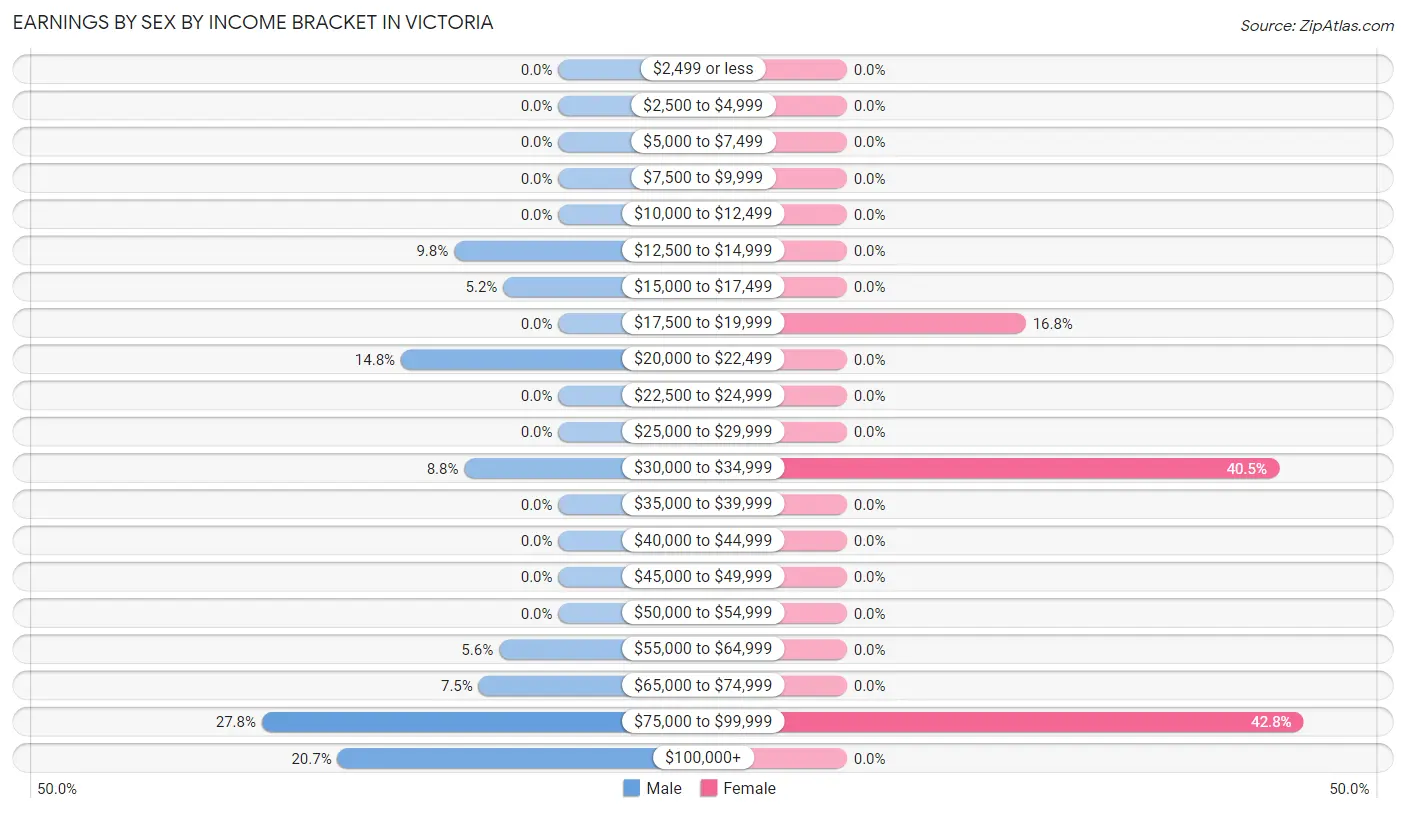
| Income | Male | Female |
| $2,499 or less | 0 (0.0%) | 0 (0.0%) |
| $2,500 to $4,999 | 0 (0.0%) | 0 (0.0%) |
| $5,000 to $7,499 | 0 (0.0%) | 0 (0.0%) |
| $7,500 to $9,999 | 0 (0.0%) | 0 (0.0%) |
| $10,000 to $12,499 | 0 (0.0%) | 0 (0.0%) |
| $12,500 to $14,999 | 51 (9.8%) | 0 (0.0%) |
| $15,000 to $17,499 | 27 (5.2%) | 0 (0.0%) |
| $17,500 to $19,999 | 0 (0.0%) | 29 (16.8%) |
| $20,000 to $22,499 | 77 (14.7%) | 0 (0.0%) |
| $22,500 to $24,999 | 0 (0.0%) | 0 (0.0%) |
| $25,000 to $29,999 | 0 (0.0%) | 0 (0.0%) |
| $30,000 to $34,999 | 46 (8.8%) | 70 (40.5%) |
| $35,000 to $39,999 | 0 (0.0%) | 0 (0.0%) |
| $40,000 to $44,999 | 0 (0.0%) | 0 (0.0%) |
| $45,000 to $49,999 | 0 (0.0%) | 0 (0.0%) |
| $50,000 to $54,999 | 0 (0.0%) | 0 (0.0%) |
| $55,000 to $64,999 | 29 (5.6%) | 0 (0.0%) |
| $65,000 to $74,999 | 39 (7.5%) | 0 (0.0%) |
| $75,000 to $99,999 | 145 (27.8%) | 74 (42.8%) |
| $100,000+ | 108 (20.7%) | 0 (0.0%) |
| Total | 522 (100.0%) | 173 (100.0%) |
Earnings by Sex by Educational Attainment in Victoria

| Educational Attainment | Male Income | Female Income |
| Less than High School | - | - |
| High School Diploma | - | - |
| College or Associate's Degree | $98,268 | $0 |
| Bachelor's Degree | - | - |
| Graduate Degree | - | - |
| Total | $66,987 | $0 |
Family Income in Victoria
Family Income Brackets in Victoria
According to the Victoria family income data, there are 137 families falling into the $200,000+ income range, which is the most common income bracket and makes up 42.8% of all families.

| Income Bracket | # Families | % Families |
| Less than $10,000 | 14 | 4.4% |
| $10,000 to $14,999 | 0 | 0.0% |
| $15,000 to $24,999 | 18 | 5.6% |
| $25,000 to $34,999 | 9 | 2.8% |
| $35,000 to $49,999 | 27 | 8.4% |
| $50,000 to $74,999 | 83 | 25.9% |
| $75,000 to $99,999 | 32 | 10.0% |
| $100,000 to $149,999 | 0 | 0.0% |
| $150,000 to $199,999 | 0 | 0.0% |
| $200,000+ | 137 | 42.8% |
Family Income by Famaliy Size in Victoria
3-person families (181 | 56.6%) account for the highest median family income in Victoria with $218,015 per family, while 3-person families (181 | 56.6%) have the highest median income of $72,672 per family member.

| Income Bracket | # Families | Median Income |
| 2-Person Families | 84 (26.3%) | $0 |
| 3-Person Families | 181 (56.6%) | $218,015 |
| 4-Person Families | 55 (17.2%) | $0 |
| 5-Person Families | 0 (0.0%) | $0 |
| 6-Person Families | 0 (0.0%) | $0 |
| 7+ Person Families | 0 (0.0%) | $0 |
| Total | 320 (100.0%) | $0 |
Family Income by Number of Earners in Victoria

| Number of Earners | # Families | Median Income |
| No Earners | 41 (12.8%) | $23,403 |
| 1 Earner | 66 (20.6%) | $0 |
| 2 Earners | 99 (30.9%) | $0 |
| 3+ Earners | 114 (35.6%) | $0 |
| Total | 320 (100.0%) | $0 |
Household Income in Victoria
Household Income Brackets in Victoria
With 154 households falling in the category, the $200,000+ income range is the most frequent in Victoria, accounting for 26.0% of all households.

| Income Bracket | # Households | % Households |
| Less than $10,000 | 14 | 2.4% |
| $10,000 to $14,999 | 0 | 0.0% |
| $15,000 to $24,999 | 107 | 18.0% |
| $25,000 to $34,999 | 41 | 6.9% |
| $35,000 to $49,999 | 46 | 7.8% |
| $50,000 to $74,999 | 83 | 14.0% |
| $75,000 to $99,999 | 32 | 5.4% |
| $100,000 to $149,999 | 85 | 14.3% |
| $150,000 to $199,999 | 31 | 5.2% |
| $200,000+ | 154 | 26.0% |
Household Income by Householder Age in Victoria
The median household income in Victoria is $92,930, with the highest median household income of $218,410 found in the 45 to 64 years age bracket for the primary householder. A total of 191 households (32.2%) fall into this category.

| Income Bracket | # Households | Median Income |
| 15 to 24 Years | 0 (0.0%) | $0 |
| 25 to 44 Years | 156 (26.3%) | $107,706 |
| 45 to 64 Years | 191 (32.2%) | $218,410 |
| 65+ Years | 246 (41.5%) | $28,750 |
| Total | 593 (100.0%) | $92,930 |
Poverty in Victoria
Income Below Poverty by Sex and Age in Victoria
With 5.4% poverty level for males and 2.5% for females among the residents of Victoria, 6 to 11 year old males and 45 to 54 year old females are the most vulnerable to poverty, with 20 males (100.0%) and 14 females (9.0%) in their respective age groups living below the poverty level.
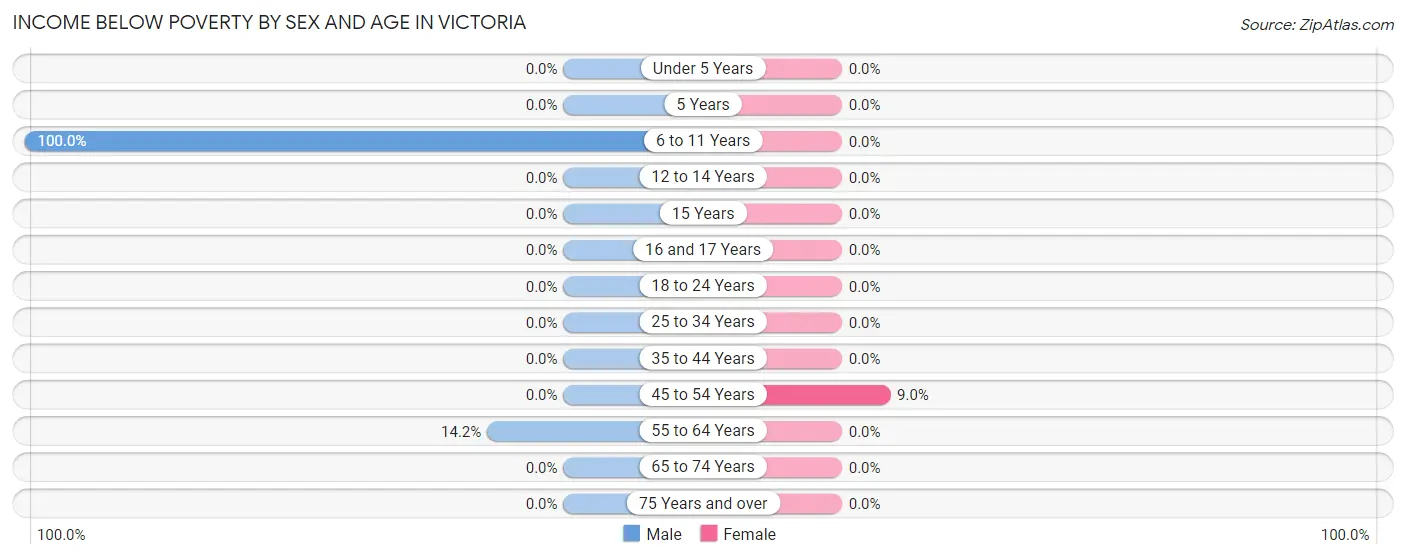
| Age Bracket | Male | Female |
| Under 5 Years | 0 (0.0%) | 0 (0.0%) |
| 5 Years | 0 (0.0%) | 0 (0.0%) |
| 6 to 11 Years | 20 (100.0%) | 0 (0.0%) |
| 12 to 14 Years | 0 (0.0%) | 0 (0.0%) |
| 15 Years | 0 (0.0%) | 0 (0.0%) |
| 16 and 17 Years | 0 (0.0%) | 0 (0.0%) |
| 18 to 24 Years | 0 (0.0%) | 0 (0.0%) |
| 25 to 34 Years | 0 (0.0%) | 0 (0.0%) |
| 35 to 44 Years | 0 (0.0%) | 0 (0.0%) |
| 45 to 54 Years | 0 (0.0%) | 14 (9.0%) |
| 55 to 64 Years | 15 (14.1%) | 0 (0.0%) |
| 65 to 74 Years | 0 (0.0%) | 0 (0.0%) |
| 75 Years and over | 0 (0.0%) | 0 (0.0%) |
| Total | 35 (5.4%) | 14 (2.5%) |
Income Above Poverty by Sex and Age in Victoria
According to the poverty statistics in Victoria, males aged 12 to 14 years and females aged 12 to 14 years are the age groups that are most secure financially, with 100.0% of males and 100.0% of females in these age groups living above the poverty line.
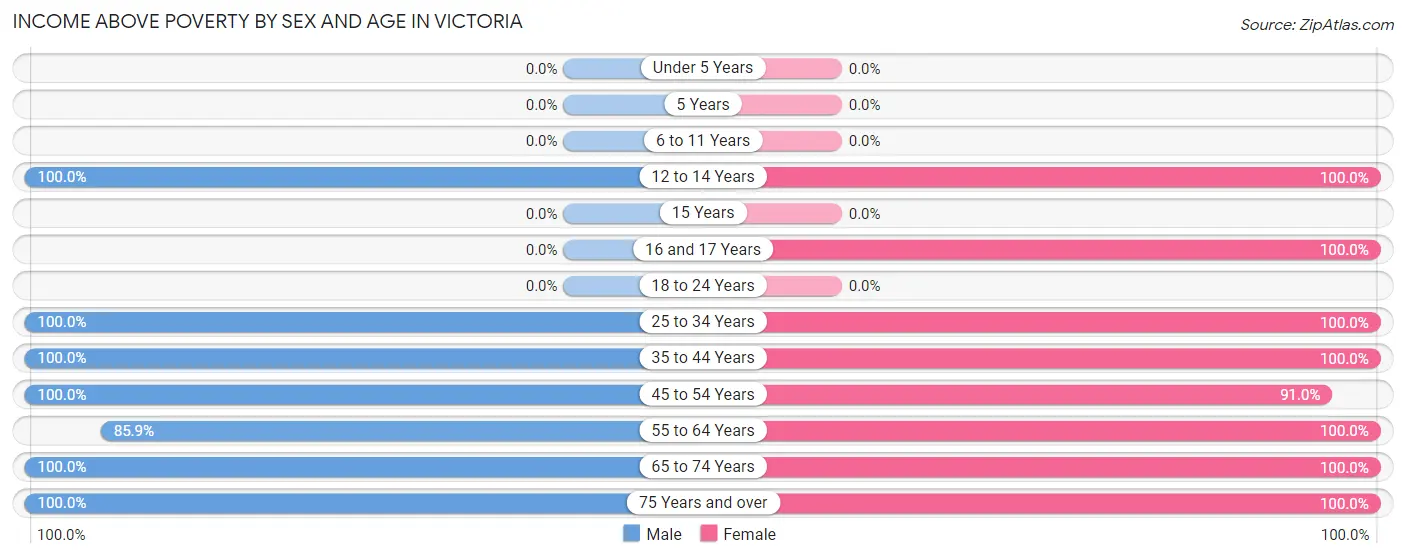
| Age Bracket | Male | Female |
| Under 5 Years | 0 (0.0%) | 0 (0.0%) |
| 5 Years | 0 (0.0%) | 0 (0.0%) |
| 6 to 11 Years | 0 (0.0%) | 0 (0.0%) |
| 12 to 14 Years | 18 (100.0%) | 23 (100.0%) |
| 15 Years | 0 (0.0%) | 0 (0.0%) |
| 16 and 17 Years | 0 (0.0%) | 38 (100.0%) |
| 18 to 24 Years | 0 (0.0%) | 0 (0.0%) |
| 25 to 34 Years | 123 (100.0%) | 38 (100.0%) |
| 35 to 44 Years | 153 (100.0%) | 54 (100.0%) |
| 45 to 54 Years | 137 (100.0%) | 142 (91.0%) |
| 55 to 64 Years | 91 (85.9%) | 39 (100.0%) |
| 65 to 74 Years | 56 (100.0%) | 100 (100.0%) |
| 75 Years and over | 37 (100.0%) | 104 (100.0%) |
| Total | 615 (94.6%) | 538 (97.5%) |
Income Below Poverty Among Married-Couple Families in Victoria
The poverty statistics for married-couple families in Victoria show that 4.4% or 14 of the total 320 families live below the poverty line. Families with 1 or 2 children have the highest poverty rate of 20.3%, comprising of 14 families. On the other hand, families with no children have the lowest poverty rate of 0.0%, which includes 0 families.

| Children | Above Poverty | Below Poverty |
| No Children | 251 (100.0%) | 0 (0.0%) |
| 1 or 2 Children | 55 (79.7%) | 14 (20.3%) |
| 3 or 4 Children | 0 (0.0%) | 0 (0.0%) |
| 5 or more Children | 0 (0.0%) | 0 (0.0%) |
| Total | 306 (95.6%) | 14 (4.4%) |
Income Below Poverty Among Single-Parent Households in Victoria

| Children | Single Father | Single Mother |
| No Children | 0 (0.0%) | 0 (0.0%) |
| 1 or 2 Children | 0 (0.0%) | 0 (0.0%) |
| 3 or 4 Children | 0 (0.0%) | 0 (0.0%) |
| 5 or more Children | 0 (0.0%) | 0 (0.0%) |
| Total | 0 (0.0%) | 0 (0.0%) |
Income Below Poverty Among Married-Couple vs Single-Parent Households in Victoria

| Children | Married-Couple Families | Single-Parent Households |
| No Children | 0 (0.0%) | 0 (0.0%) |
| 1 or 2 Children | 14 (20.3%) | 0 (0.0%) |
| 3 or 4 Children | 0 (0.0%) | 0 (0.0%) |
| 5 or more Children | 0 (0.0%) | 0 (0.0%) |
| Total | 14 (4.4%) | 0 (0.0%) |
Race in Victoria
The most populous races in Victoria are White / Caucasian (1,018 | 81.8%), Hispanic or Latino (142 | 11.4%), and Some other Race (122 | 9.8%).

| Race | # Population | % Population |
| Asian | 0 | 0.0% |
| Black / African American | 85 | 6.8% |
| Hawaiian / Pacific | 0 | 0.0% |
| Hispanic or Latino | 142 | 11.4% |
| Native / Alaskan | 0 | 0.0% |
| White / Caucasian | 1,018 | 81.8% |
| Two or more Races | 20 | 1.6% |
| Some other Race | 122 | 9.8% |
| Total | 1,245 | 100.0% |
Ancestry in Victoria
The most populous ancestries reported in Victoria are English (313 | 25.1%), Irish (148 | 11.9%), Mexican (122 | 9.8%), American (107 | 8.6%), and Italian (74 | 5.9%), together accounting for 61.4% of all Victoria residents.

| Ancestry | # Population | % Population |
| American | 107 | 8.6% |
| English | 313 | 25.1% |
| French | 24 | 1.9% |
| German | 32 | 2.6% |
| Irish | 148 | 11.9% |
| Italian | 74 | 5.9% |
| Mexican | 122 | 9.8% |
| Puerto Rican | 20 | 1.6% | View All 8 Rows |
Immigrants in Victoria
The most numerous immigrant groups reported in Victoria came from Central America (22 | 1.8%), Latin America (22 | 1.8%), and Mexico (22 | 1.8%), together accounting for 5.3% of all Victoria residents.

| Immigration Origin | # Population | % Population |
| Central America | 22 | 1.8% |
| Latin America | 22 | 1.8% |
| Mexico | 22 | 1.8% | View All 3 Rows |
Sex and Age in Victoria
Sex and Age in Victoria
The most populous age groups in Victoria are 40 to 44 Years (124 | 18.6%) for men and 45 to 49 Years (113 | 19.6%) for women.
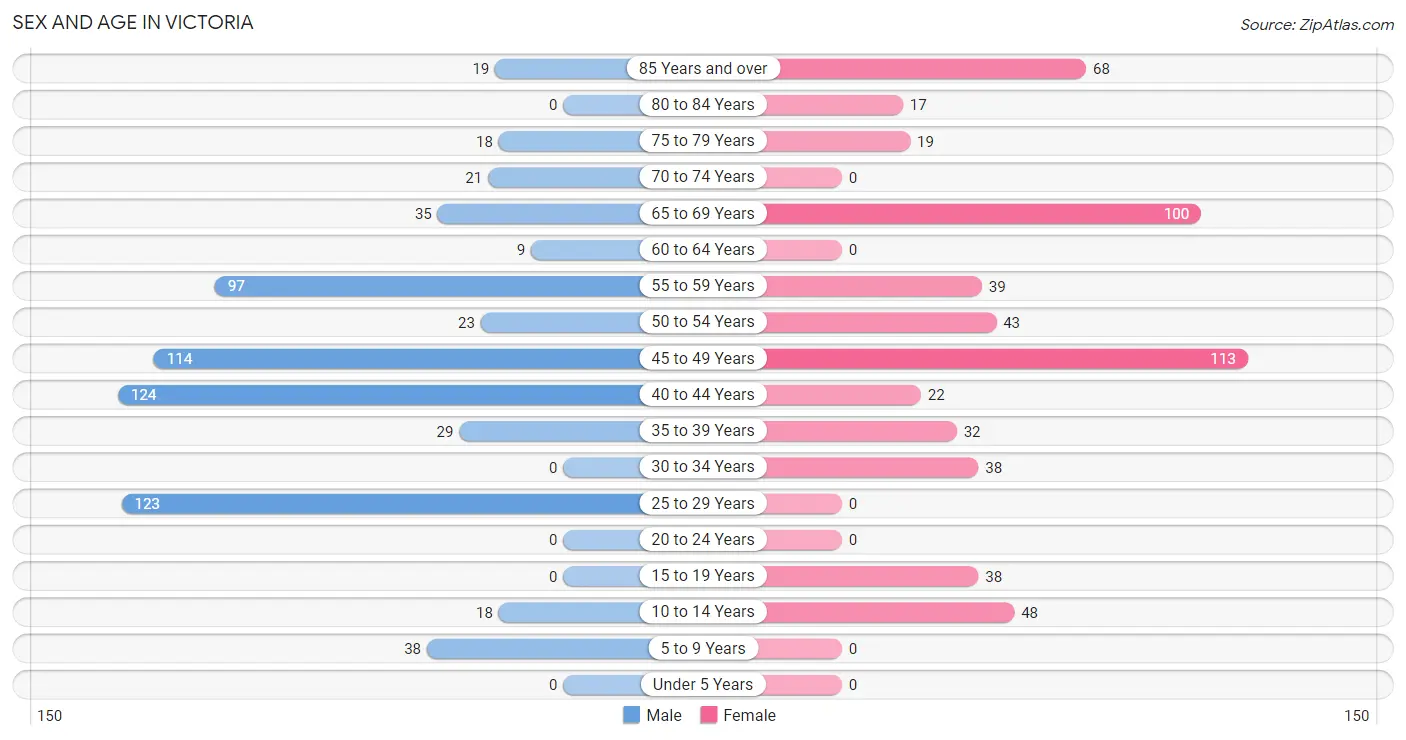
| Age Bracket | Male | Female |
| Under 5 Years | 0 (0.0%) | 0 (0.0%) |
| 5 to 9 Years | 38 (5.7%) | 0 (0.0%) |
| 10 to 14 Years | 18 (2.7%) | 48 (8.3%) |
| 15 to 19 Years | 0 (0.0%) | 38 (6.6%) |
| 20 to 24 Years | 0 (0.0%) | 0 (0.0%) |
| 25 to 29 Years | 123 (18.4%) | 0 (0.0%) |
| 30 to 34 Years | 0 (0.0%) | 38 (6.6%) |
| 35 to 39 Years | 29 (4.3%) | 32 (5.6%) |
| 40 to 44 Years | 124 (18.6%) | 22 (3.8%) |
| 45 to 49 Years | 114 (17.1%) | 113 (19.6%) |
| 50 to 54 Years | 23 (3.4%) | 43 (7.4%) |
| 55 to 59 Years | 97 (14.5%) | 39 (6.8%) |
| 60 to 64 Years | 9 (1.3%) | 0 (0.0%) |
| 65 to 69 Years | 35 (5.2%) | 100 (17.3%) |
| 70 to 74 Years | 21 (3.1%) | 0 (0.0%) |
| 75 to 79 Years | 18 (2.7%) | 19 (3.3%) |
| 80 to 84 Years | 0 (0.0%) | 17 (2.9%) |
| 85 Years and over | 19 (2.8%) | 68 (11.8%) |
| Total | 668 (100.0%) | 577 (100.0%) |
Families and Households in Victoria
Median Family Size in Victoria

| Family Type | # Families | Family Size |
| Married-Couple | 320 (100.0%) | 2.72 |
| Single Male/Father | 0 (0.0%) | - |
| Single Female/Mother | 0 (0.0%) | - |
| Total Families | 320 (100.0%) | 2.72 |
Median Household Size in Victoria

| Household Type | # Households | Household Size |
| Married-Couple | 320 (54.0%) | 2.85 |
| Single Male/Father | 0 (0.0%) | - |
| Single Female/Mother | 0 (0.0%) | - |
| Non-family | 273 (46.0%) | 1.22 |
| Total Households | 593 (100.0%) | 2.10 |
Household Size by Marriage Status in Victoria
Out of a total of 593 households in Victoria, 320 (54.0%) are family households, while 273 (46.0%) are nonfamily households. The most numerous type of family households are 3-person households, comprising 181, and the most common type of nonfamily households are 1-person households, comprising 242.

| Household Size | Family Households | Nonfamily Households |
| 1-Person Households | - | 242 (40.8%) |
| 2-Person Households | 84 (14.2%) | 0 (0.0%) |
| 3-Person Households | 181 (30.5%) | 31 (5.2%) |
| 4-Person Households | 23 (3.9%) | 0 (0.0%) |
| 5-Person Households | 0 (0.0%) | 0 (0.0%) |
| 6-Person Households | 32 (5.4%) | 0 (0.0%) |
| 7+ Person Households | 0 (0.0%) | 0 (0.0%) |
| Total | 320 (54.0%) | 273 (46.0%) |
Female Fertility in Victoria
Fertility by Age in Victoria

| Age Bracket | Women with Births | Births / 1,000 Women |
| 15 to 19 years | 0 (0.0%) | 0.0 |
| 20 to 34 years | 0 (0.0%) | 0.0 |
| 35 to 50 years | 0 (0.0%) | 0.0 |
| Total | 0 (0.0%) | 0.0 |
Fertility by Age by Marriage Status in Victoria

| Age Bracket | Married | Unmarried |
| 15 to 19 years | 0 (0.0%) | 0 (0.0%) |
| 20 to 34 years | 0 (0.0%) | 0 (0.0%) |
| 35 to 50 years | 0 (0.0%) | 0 (0.0%) |
| Total | 0 (0.0%) | 0 (0.0%) |
Fertility by Education in Victoria
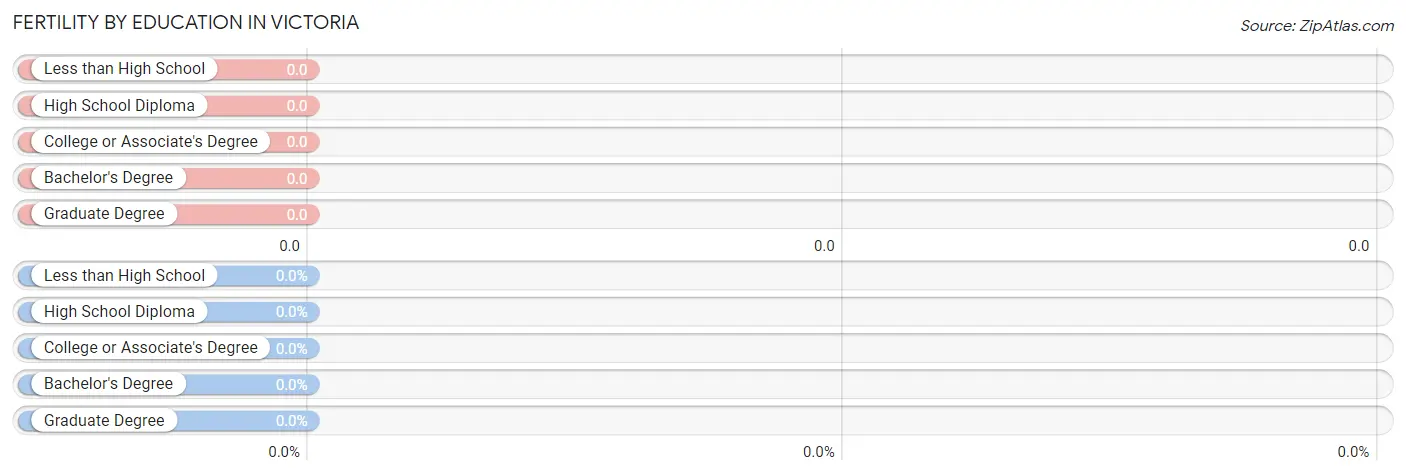
| Educational Attainment | Women with Births | Births / 1,000 Women |
| Less than High School | 0 (0.0%) | 0.0 |
| High School Diploma | 0 (0.0%) | 0.0 |
| College or Associate's Degree | 0 (0.0%) | 0.0 |
| Bachelor's Degree | 0 (0.0%) | 0.0 |
| Graduate Degree | 0 (0.0%) | 0.0 |
| Total | 0 (0.0%) | 0.0 |
Fertility by Education by Marriage Status in Victoria

| Educational Attainment | Married | Unmarried |
| Less than High School | 0 (0.0%) | 0 (0.0%) |
| High School Diploma | 0 (0.0%) | 0 (0.0%) |
| College or Associate's Degree | 0 (0.0%) | 0 (0.0%) |
| Bachelor's Degree | 0 (0.0%) | 0 (0.0%) |
| Graduate Degree | 0 (0.0%) | 0 (0.0%) |
| Total | 0 (0.0%) | 0 (0.0%) |
Employment Characteristics in Victoria
Employment by Class of Employer in Victoria
Among the 617 employed individuals in Victoria, private company employees (588 | 95.3%), and local government employees (29 | 4.7%) make up the most common classes of employment.

| Employer Class | # Employees | % Employees |
| Private Company Employees | 588 | 95.3% |
| Self-Employed (Incorporated) | 0 | 0.0% |
| Self-Employed (Not Incorporated) | 0 | 0.0% |
| Not-for-profit Organizations | 0 | 0.0% |
| Local Government Employees | 29 | 4.7% |
| State Government Employees | 0 | 0.0% |
| Federal Government Employees | 0 | 0.0% |
| Unpaid Family Workers | 0 | 0.0% |
| Total | 617 | 100.0% |
Employment Status by Age in Victoria

| Age Bracket | In Labor Force | Unemployed |
| 16 to 19 Years | 0 (0.0%) | 0 (0.0%) |
| 20 to 24 Years | 0 (0.0%) | 0 (0.0%) |
| 25 to 29 Years | 123 (100.0%) | 0 (0.0%) |
| 30 to 34 Years | 38 (100.0%) | 0 (0.0%) |
| 35 to 44 Years | 185 (89.4%) | 0 (0.0%) |
| 45 to 54 Years | 240 (81.9%) | 0 (0.0%) |
| 55 to 59 Years | 82 (60.3%) | 0 (0.0%) |
| 60 to 64 Years | 0 (0.0%) | 0 (0.0%) |
| 65 to 74 Years | 0 (0.0%) | 0 (0.0%) |
| 75 Years and over | 0 (0.0%) | 0 (0.0%) |
| Total | 667 (58.5%) | 0 (0.0%) |
Employment Status by Educational Attainment in Victoria

| Educational Attainment | In Labor Force | Unemployed |
| Less than High School | 0 (0.0%) | 0 (0.0%) |
| High School Diploma | 194 (67.4%) | 0 (0.0%) |
| College / Associate Degree | 406 (96.7%) | 0 (0.0%) |
| Bachelor's Degree or higher | 68 (100.0%) | 0 (0.0%) |
| Total | 668 (82.9%) | 0 (0.0%) |
Employment Occupations by Sex in Victoria
Management, Business, Science and Arts Occupations
The most common Management, Business, Science and Arts occupations in Victoria are Management (242 | 36.2%), Health Diagnosing & Treating (32 | 4.8%), Community & Social Service (29 | 4.3%), and Education Instruction & Library (29 | 4.3%).
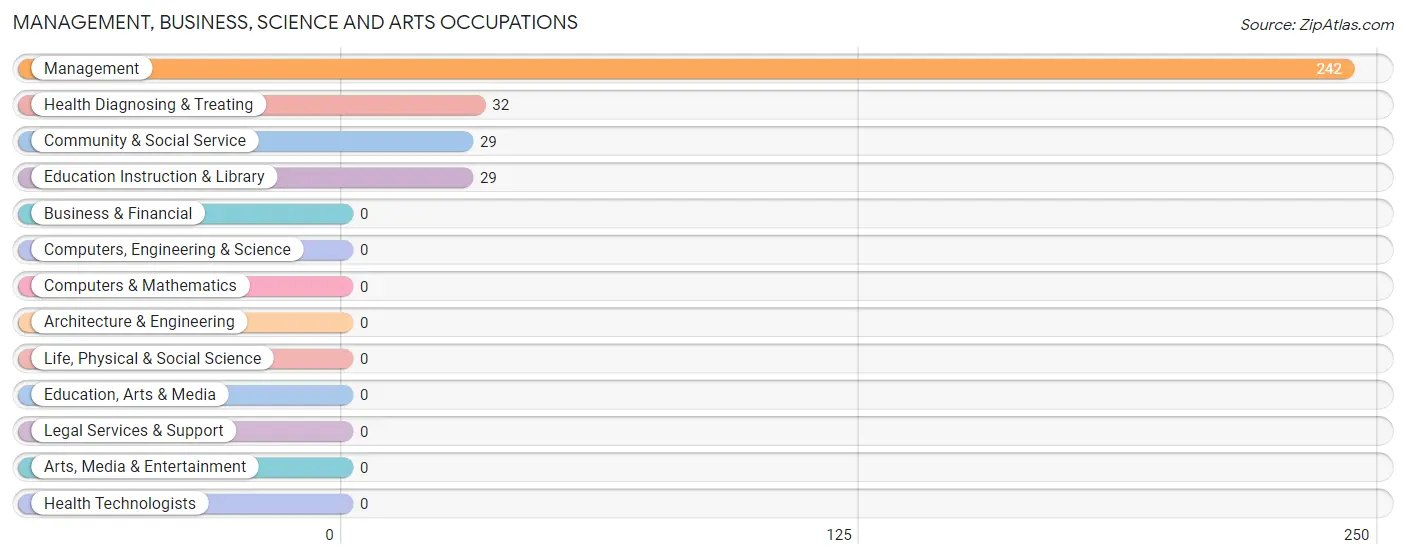
Management, Business, Science and Arts Occupations by Sex
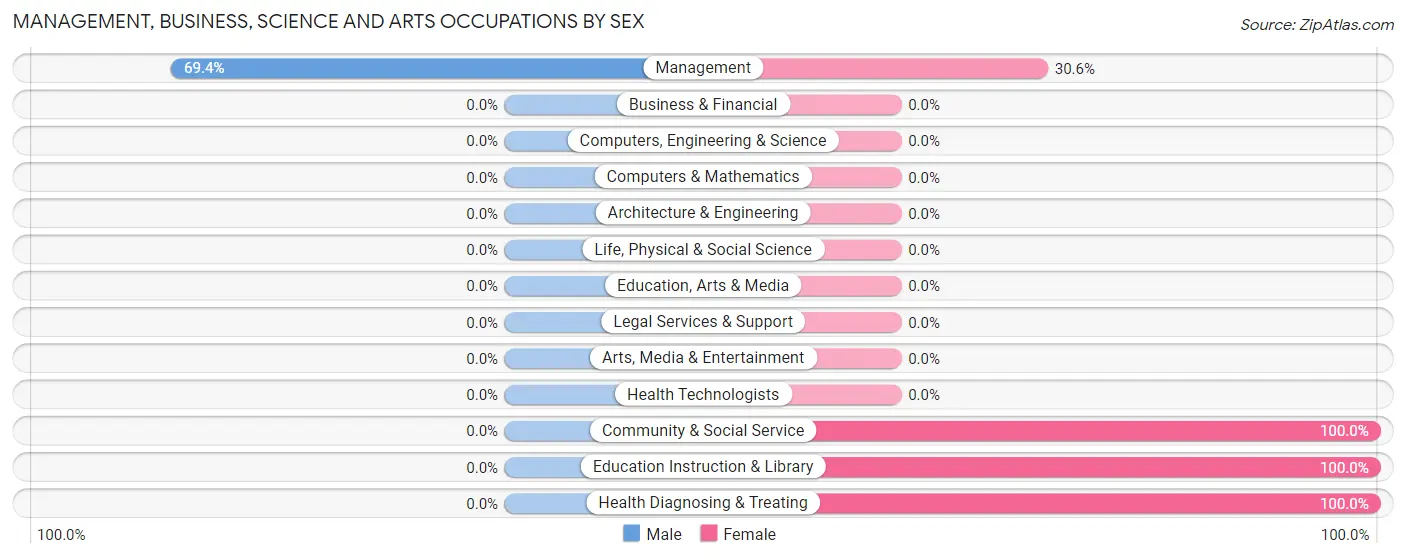
| Occupation | Male | Female |
| Management | 168 (69.4%) | 74 (30.6%) |
| Business & Financial | 0 (0.0%) | 0 (0.0%) |
| Computers, Engineering & Science | 0 (0.0%) | 0 (0.0%) |
| Computers & Mathematics | 0 (0.0%) | 0 (0.0%) |
| Architecture & Engineering | 0 (0.0%) | 0 (0.0%) |
| Life, Physical & Social Science | 0 (0.0%) | 0 (0.0%) |
| Community & Social Service | 0 (0.0%) | 29 (100.0%) |
| Education, Arts & Media | 0 (0.0%) | 0 (0.0%) |
| Legal Services & Support | 0 (0.0%) | 0 (0.0%) |
| Education Instruction & Library | 0 (0.0%) | 29 (100.0%) |
| Arts, Media & Entertainment | 0 (0.0%) | 0 (0.0%) |
| Health Diagnosing & Treating | 0 (0.0%) | 32 (100.0%) |
| Health Technologists | 0 (0.0%) | 0 (0.0%) |
| Total (Category) | 168 (55.4%) | 135 (44.6%) |
| Total (Overall) | 495 (74.1%) | 173 (25.9%) |
Services Occupations
The most common Services occupations in Victoria are , and Food Preparation & Serving (51 | 7.6%).

Services Occupations by Sex

| Occupation | Male | Female |
| Healthcare Support | 0 (0.0%) | 0 (0.0%) |
| Security & Protection | 0 (0.0%) | 0 (0.0%) |
| Firefighting & Prevention | 0 (0.0%) | 0 (0.0%) |
| Law Enforcement | 0 (0.0%) | 0 (0.0%) |
| Food Preparation & Serving | 51 (100.0%) | 0 (0.0%) |
| Cleaning & Maintenance | 0 (0.0%) | 0 (0.0%) |
| Personal Care & Service | 0 (0.0%) | 0 (0.0%) |
| Total (Category) | 51 (100.0%) | 0 (0.0%) |
| Total (Overall) | 495 (74.1%) | 173 (25.9%) |
Sales and Office Occupations
The most common Sales and Office occupations in Victoria are Office & Administration (77 | 11.5%), and Sales & Related (38 | 5.7%).

Sales and Office Occupations by Sex

| Occupation | Male | Female |
| Sales & Related | 0 (0.0%) | 38 (100.0%) |
| Office & Administration | 77 (100.0%) | 0 (0.0%) |
| Total (Category) | 77 (67.0%) | 38 (33.0%) |
| Total (Overall) | 495 (74.1%) | 173 (25.9%) |
Natural Resources, Construction and Maintenance Occupations
The most common Natural Resources, Construction and Maintenance occupations in Victoria are Installation, Maintenance & Repair (85 | 12.7%), and Construction & Extraction (29 | 4.3%).

Natural Resources, Construction and Maintenance Occupations by Sex

| Occupation | Male | Female |
| Farming, Fishing & Forestry | 0 (0.0%) | 0 (0.0%) |
| Construction & Extraction | 29 (100.0%) | 0 (0.0%) |
| Installation, Maintenance & Repair | 85 (100.0%) | 0 (0.0%) |
| Total (Category) | 114 (100.0%) | 0 (0.0%) |
| Total (Overall) | 495 (74.1%) | 173 (25.9%) |
Production, Transportation and Moving Occupations
The most common Production, Transportation and Moving occupations in Victoria are , and Transportation (85 | 12.7%).

Production, Transportation and Moving Occupations by Sex

| Occupation | Male | Female |
| Production | 0 (0.0%) | 0 (0.0%) |
| Transportation | 85 (100.0%) | 0 (0.0%) |
| Material Moving | 0 (0.0%) | 0 (0.0%) |
| Total (Category) | 85 (100.0%) | 0 (0.0%) |
| Total (Overall) | 495 (74.1%) | 173 (25.9%) |
Employment Industries by Sex in Victoria
Employment Industries in Victoria
The major employment industries in Victoria include Transportation & Warehousing (198 | 29.6%), Manufacturing (168 | 25.2%), Educational Services (80 | 12.0%), Information (77 | 11.5%), and Retail Trade (46 | 6.9%).
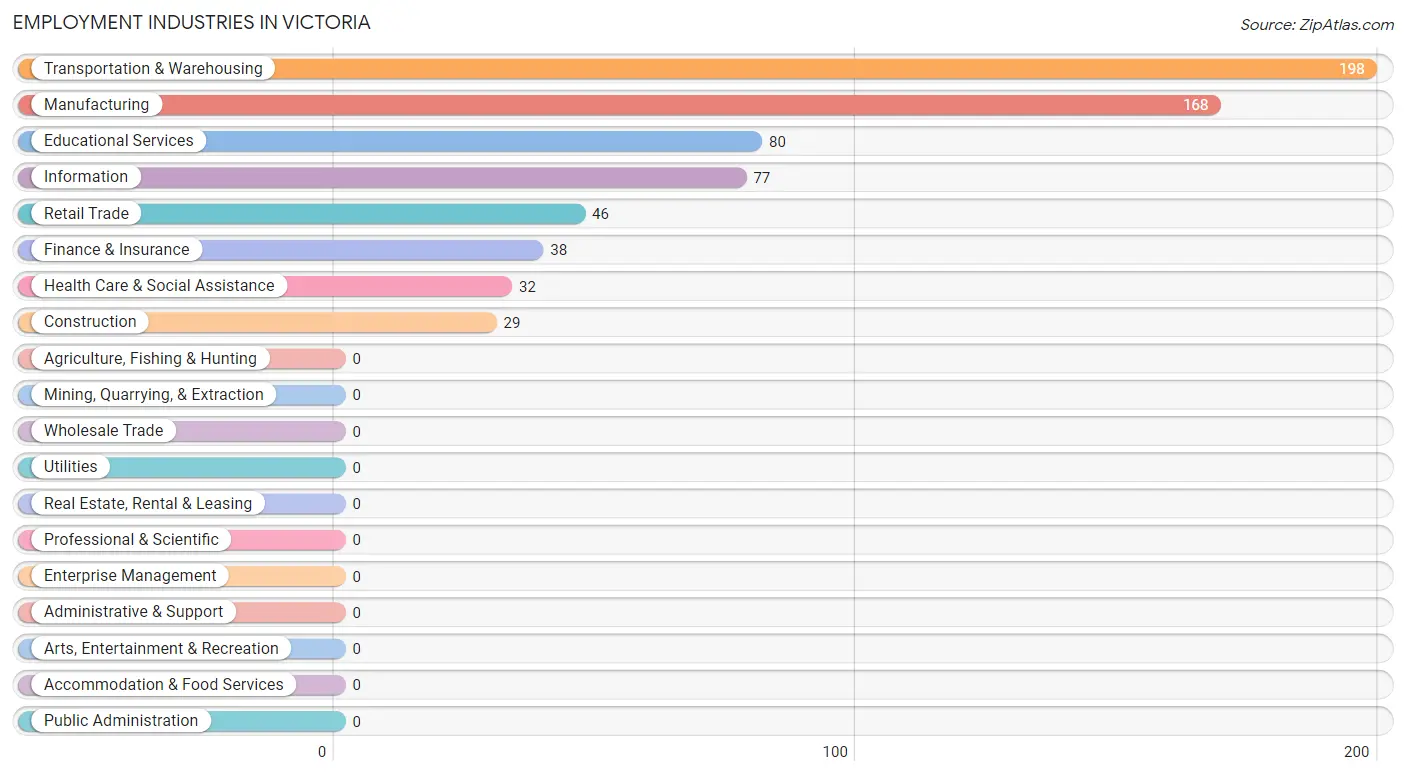
Employment Industries by Sex in Victoria
The Victoria industries that see more men than women are Construction (100.0%), Manufacturing (100.0%), and Retail Trade (100.0%), whereas the industries that tend to have a higher number of women are Finance & Insurance (100.0%), Health Care & Social Assistance (100.0%), and Transportation & Warehousing (37.4%).
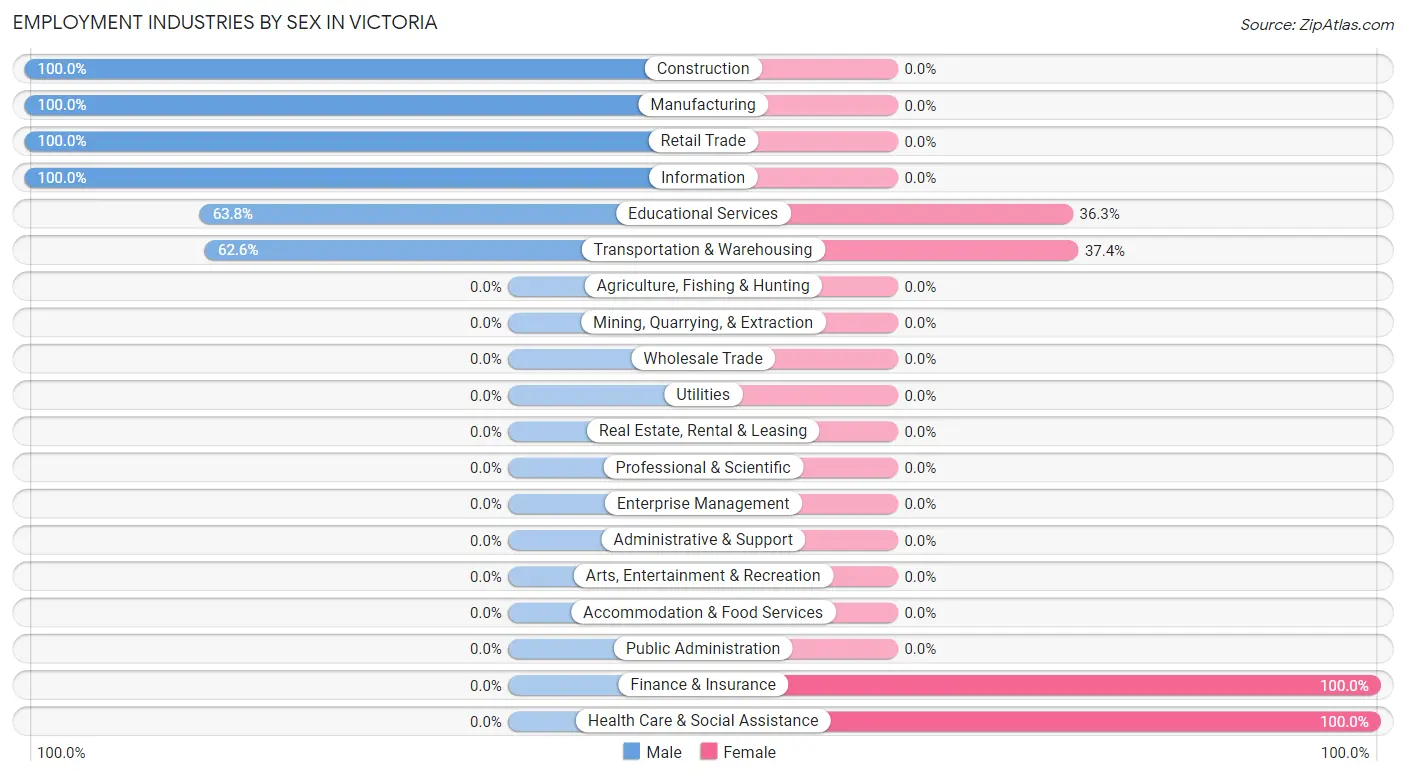
| Industry | Male | Female |
| Agriculture, Fishing & Hunting | 0 (0.0%) | 0 (0.0%) |
| Mining, Quarrying, & Extraction | 0 (0.0%) | 0 (0.0%) |
| Construction | 29 (100.0%) | 0 (0.0%) |
| Manufacturing | 168 (100.0%) | 0 (0.0%) |
| Wholesale Trade | 0 (0.0%) | 0 (0.0%) |
| Retail Trade | 46 (100.0%) | 0 (0.0%) |
| Transportation & Warehousing | 124 (62.6%) | 74 (37.4%) |
| Utilities | 0 (0.0%) | 0 (0.0%) |
| Information | 77 (100.0%) | 0 (0.0%) |
| Finance & Insurance | 0 (0.0%) | 38 (100.0%) |
| Real Estate, Rental & Leasing | 0 (0.0%) | 0 (0.0%) |
| Professional & Scientific | 0 (0.0%) | 0 (0.0%) |
| Enterprise Management | 0 (0.0%) | 0 (0.0%) |
| Administrative & Support | 0 (0.0%) | 0 (0.0%) |
| Educational Services | 51 (63.7%) | 29 (36.2%) |
| Health Care & Social Assistance | 0 (0.0%) | 32 (100.0%) |
| Arts, Entertainment & Recreation | 0 (0.0%) | 0 (0.0%) |
| Accommodation & Food Services | 0 (0.0%) | 0 (0.0%) |
| Public Administration | 0 (0.0%) | 0 (0.0%) |
| Total | 495 (74.1%) | 173 (25.9%) |
Education in Victoria
School Enrollment in Victoria
The most common levels of schooling among the 172 students in Victoria are middle school (96 | 55.8%), elementary school (38 | 22.1%), and high school (38 | 22.1%).

| School Level | # Students | % Students |
| Nursery / Preschool | 0 | 0.0% |
| Kindergarten | 0 | 0.0% |
| Elementary School | 38 | 22.1% |
| Middle School | 96 | 55.8% |
| High School | 38 | 22.1% |
| College / Undergraduate | 0 | 0.0% |
| Graduate / Professional | 0 | 0.0% |
| Total | 172 | 100.0% |
School Enrollment by Age by Funding Source in Victoria
Out of a total of 172 students who are enrolled in schools in Victoria, 38 (22.1%) attend a private institution, while the remaining 134 (77.9%) are enrolled in public schools. The age group of 15 to 17 year olds has the highest likelihood of being enrolled in private schools, with 38 (100.0% in the age bracket) enrolled. Conversely, the age group of 5 to 9 year old has the lowest likelihood of being enrolled in a private school, with 38 (100.0% in the age bracket) attending a public institution.

| Age Bracket | Public School | Private School |
| 3 to 4 Year Olds | 0 (0.0%) | 0 (0.0%) |
| 5 to 9 Year Old | 38 (100.0%) | 0 (0.0%) |
| 10 to 14 Year Olds | 66 (100.0%) | 0 (0.0%) |
| 15 to 17 Year Olds | 0 (0.0%) | 38 (100.0%) |
| 18 to 19 Year Olds | 0 (0.0%) | 0 (0.0%) |
| 20 to 24 Year Olds | 0 (0.0%) | 0 (0.0%) |
| 25 to 34 Year Olds | 0 (0.0%) | 0 (0.0%) |
| 35 Years and over | 30 (100.0%) | 0 (0.0%) |
| Total | 134 (77.9%) | 38 (22.1%) |
Educational Attainment by Field of Study in Victoria
Business (39 | 57.4%), and bio, nature & agricultural (29 | 42.6%) are the most common fields of study among 68 individuals in Victoria who have obtained a bachelor's degree or higher.
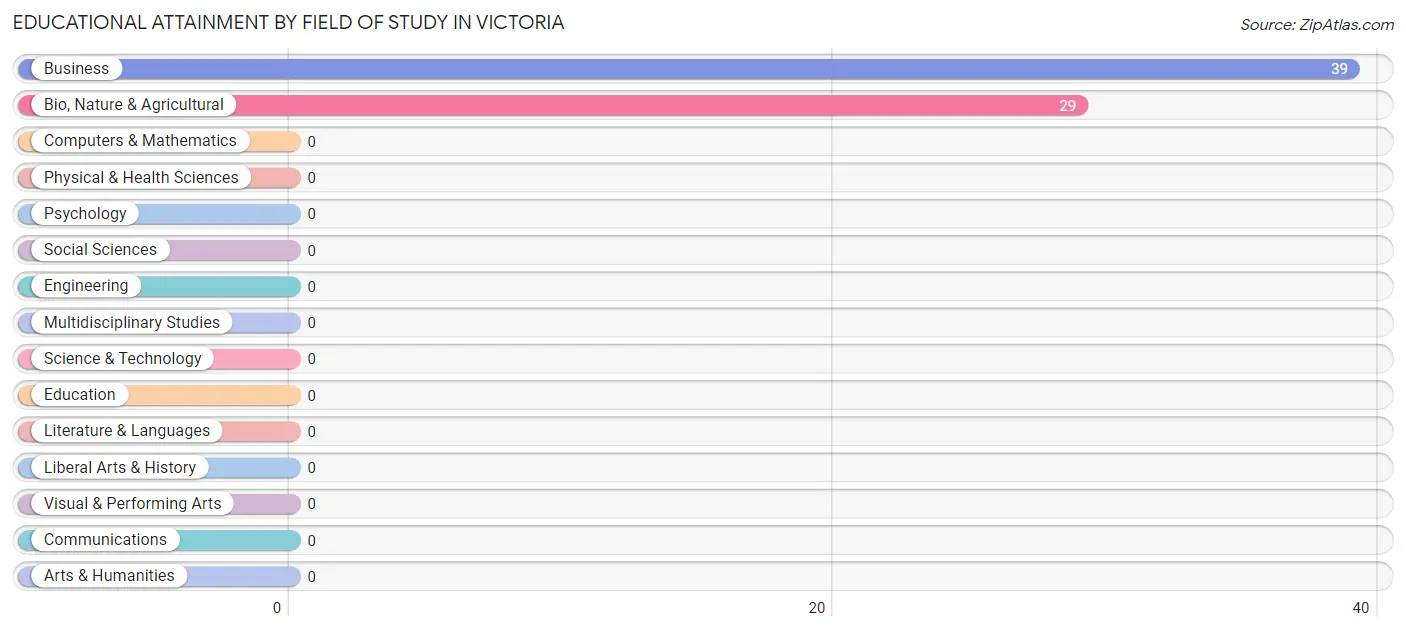
| Field of Study | # Graduates | % Graduates |
| Computers & Mathematics | 0 | 0.0% |
| Bio, Nature & Agricultural | 29 | 42.6% |
| Physical & Health Sciences | 0 | 0.0% |
| Psychology | 0 | 0.0% |
| Social Sciences | 0 | 0.0% |
| Engineering | 0 | 0.0% |
| Multidisciplinary Studies | 0 | 0.0% |
| Science & Technology | 0 | 0.0% |
| Business | 39 | 57.4% |
| Education | 0 | 0.0% |
| Literature & Languages | 0 | 0.0% |
| Liberal Arts & History | 0 | 0.0% |
| Visual & Performing Arts | 0 | 0.0% |
| Communications | 0 | 0.0% |
| Arts & Humanities | 0 | 0.0% |
| Total | 68 | 100.0% |
Transportation & Commute in Victoria
Vehicle Availability by Sex in Victoria
The most prevalent vehicle ownership categories in Victoria are males with 3 vehicles (199, accounting for 44.8%) and females with 3 vehicles (112, making up 115.0%).

| Vehicles Available | Male | Female |
| No Vehicle | 0 (0.0%) | 0 (0.0%) |
| 1 Vehicle | 0 (0.0%) | 0 (0.0%) |
| 2 Vehicles | 145 (32.7%) | 61 (35.3%) |
| 3 Vehicles | 199 (44.8%) | 112 (64.7%) |
| 4 Vehicles | 100 (22.5%) | 0 (0.0%) |
| 5 or more Vehicles | 0 (0.0%) | 0 (0.0%) |
| Total | 444 (100.0%) | 173 (100.0%) |
Commute Time in Victoria
The most frequently occuring commute durations in Victoria are 45 to 59 minutes (206 commuters, 33.4%), 20 to 24 minutes (160 commuters, 25.9%), and 35 to 39 minutes (139 commuters, 22.5%).
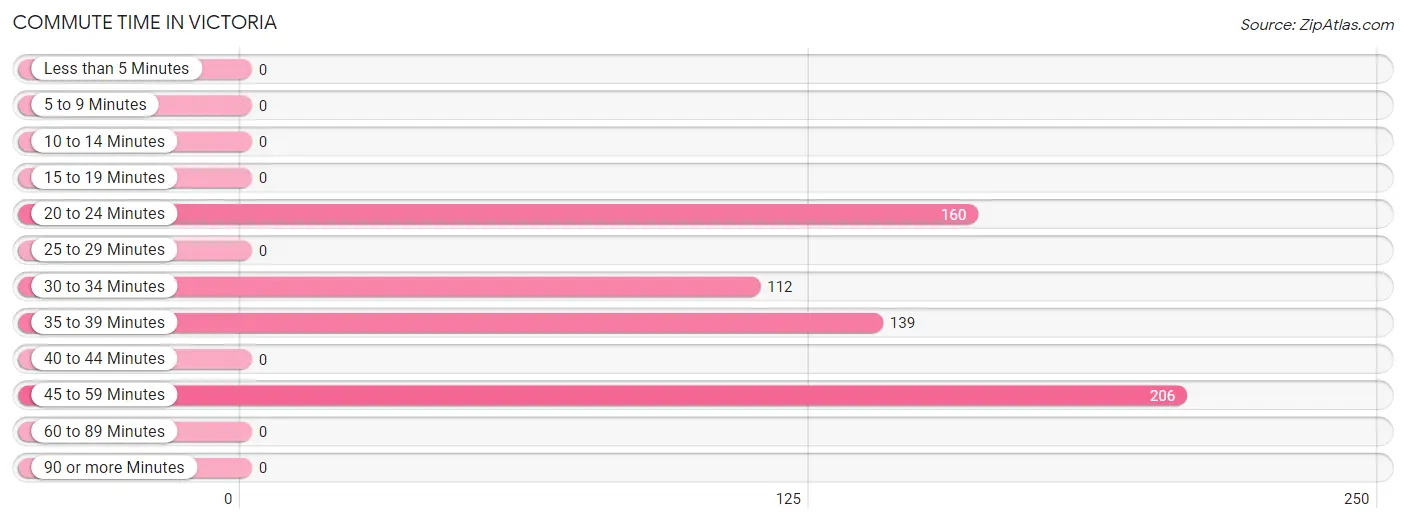
| Commute Time | # Commuters | % Commuters |
| Less than 5 Minutes | 0 | 0.0% |
| 5 to 9 Minutes | 0 | 0.0% |
| 10 to 14 Minutes | 0 | 0.0% |
| 15 to 19 Minutes | 0 | 0.0% |
| 20 to 24 Minutes | 160 | 25.9% |
| 25 to 29 Minutes | 0 | 0.0% |
| 30 to 34 Minutes | 112 | 18.1% |
| 35 to 39 Minutes | 139 | 22.5% |
| 40 to 44 Minutes | 0 | 0.0% |
| 45 to 59 Minutes | 206 | 33.4% |
| 60 to 89 Minutes | 0 | 0.0% |
| 90 or more Minutes | 0 | 0.0% |
Commute Time by Sex in Victoria
The most common commute times in Victoria are 20 to 24 minutes (160 commuters, 36.0%) for males and 30 to 34 minutes (112 commuters, 64.7%) for females.
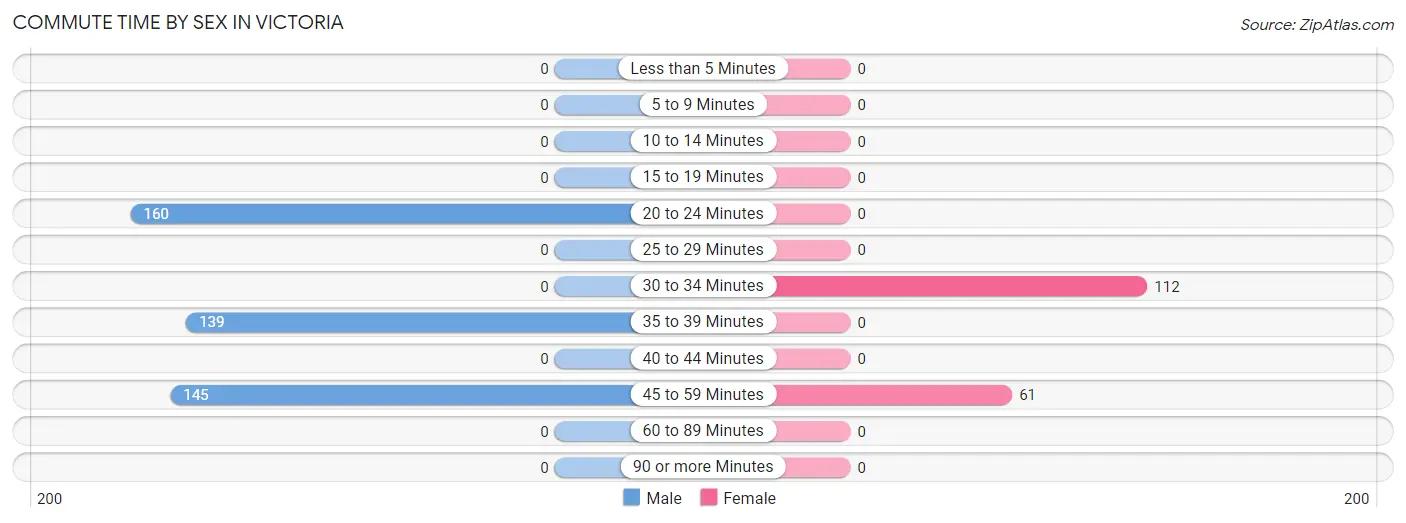
| Commute Time | Male | Female |
| Less than 5 Minutes | 0 (0.0%) | 0 (0.0%) |
| 5 to 9 Minutes | 0 (0.0%) | 0 (0.0%) |
| 10 to 14 Minutes | 0 (0.0%) | 0 (0.0%) |
| 15 to 19 Minutes | 0 (0.0%) | 0 (0.0%) |
| 20 to 24 Minutes | 160 (36.0%) | 0 (0.0%) |
| 25 to 29 Minutes | 0 (0.0%) | 0 (0.0%) |
| 30 to 34 Minutes | 0 (0.0%) | 112 (64.7%) |
| 35 to 39 Minutes | 139 (31.3%) | 0 (0.0%) |
| 40 to 44 Minutes | 0 (0.0%) | 0 (0.0%) |
| 45 to 59 Minutes | 145 (32.7%) | 61 (35.3%) |
| 60 to 89 Minutes | 0 (0.0%) | 0 (0.0%) |
| 90 or more Minutes | 0 (0.0%) | 0 (0.0%) |
Time of Departure to Work by Sex in Victoria
The most frequent times of departure to work in Victoria are 7:00 AM to 7:29 AM (185, 41.7%) for males and 6:30 AM to 6:59 AM (74, 42.8%) for females.
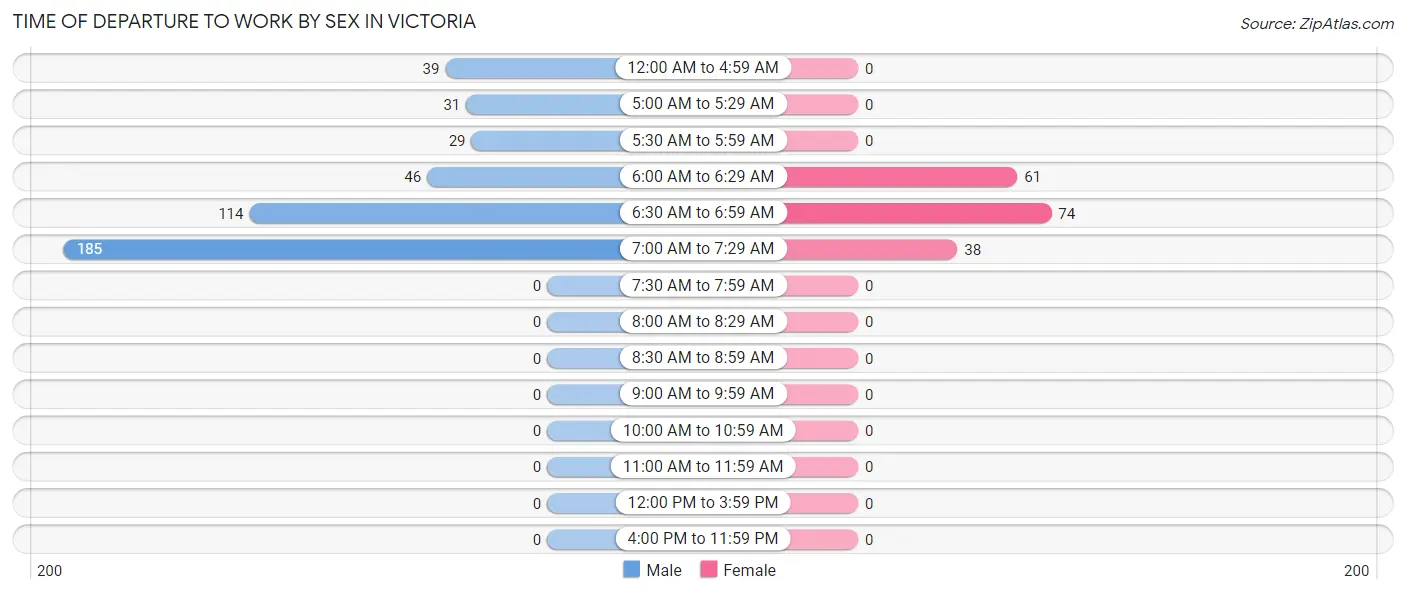
| Time of Departure | Male | Female |
| 12:00 AM to 4:59 AM | 39 (8.8%) | 0 (0.0%) |
| 5:00 AM to 5:29 AM | 31 (7.0%) | 0 (0.0%) |
| 5:30 AM to 5:59 AM | 29 (6.5%) | 0 (0.0%) |
| 6:00 AM to 6:29 AM | 46 (10.4%) | 61 (35.3%) |
| 6:30 AM to 6:59 AM | 114 (25.7%) | 74 (42.8%) |
| 7:00 AM to 7:29 AM | 185 (41.7%) | 38 (22.0%) |
| 7:30 AM to 7:59 AM | 0 (0.0%) | 0 (0.0%) |
| 8:00 AM to 8:29 AM | 0 (0.0%) | 0 (0.0%) |
| 8:30 AM to 8:59 AM | 0 (0.0%) | 0 (0.0%) |
| 9:00 AM to 9:59 AM | 0 (0.0%) | 0 (0.0%) |
| 10:00 AM to 10:59 AM | 0 (0.0%) | 0 (0.0%) |
| 11:00 AM to 11:59 AM | 0 (0.0%) | 0 (0.0%) |
| 12:00 PM to 3:59 PM | 0 (0.0%) | 0 (0.0%) |
| 4:00 PM to 11:59 PM | 0 (0.0%) | 0 (0.0%) |
| Total | 444 (100.0%) | 173 (100.0%) |
Housing Occupancy in Victoria
Occupancy by Ownership in Victoria
Of the total 593 dwellings in Victoria, owner-occupied units account for 593 (100.0%), while renter-occupied units make up 0 (0.0%).

| Occupancy | # Housing Units | % Housing Units |
| Owner Occupied Housing Units | 593 | 100.0% |
| Renter-Occupied Housing Units | 0 | 0.0% |
| Total Occupied Housing Units | 593 | 100.0% |
Occupancy by Household Size in Victoria

| Household Size | # Housing Units | % Housing Units |
| 1-Person Household | 242 | 40.8% |
| 2-Person Household | 84 | 14.2% |
| 3-Person Household | 212 | 35.7% |
| 4+ Person Household | 55 | 9.3% |
| Total Housing Units | 593 | 100.0% |
Occupancy by Ownership by Household Size in Victoria

| Household Size | Owner-occupied | Renter-occupied |
| 1-Person Household | 242 (100.0%) | 0 (0.0%) |
| 2-Person Household | 84 (100.0%) | 0 (0.0%) |
| 3-Person Household | 212 (100.0%) | 0 (0.0%) |
| 4+ Person Household | 55 (100.0%) | 0 (0.0%) |
| Total Housing Units | 593 (100.0%) | 0 (0.0%) |
Occupancy by Educational Attainment in Victoria

| Household Size | Owner-occupied | Renter-occupied |
| Less than High School | 68 (100.0%) | 0 (0.0%) |
| High School Diploma | 165 (100.0%) | 0 (0.0%) |
| College/Associate Degree | 321 (100.0%) | 0 (0.0%) |
| Bachelor's Degree or higher | 39 (100.0%) | 0 (0.0%) |
Occupancy by Age of Householder in Victoria

| Age Bracket | # Households | % Households |
| Under 35 Years | 0 | 0.0% |
| 35 to 44 Years | 156 | 26.3% |
| 45 to 54 Years | 151 | 25.5% |
| 55 to 64 Years | 40 | 6.8% |
| 65 to 74 Years | 124 | 20.9% |
| 75 to 84 Years | 35 | 5.9% |
| 85 Years and Over | 87 | 14.7% |
| Total | 593 | 100.0% |
Housing Finances in Victoria
Median Income by Occupancy in Victoria

| Occupancy Type | # Households | Median Income |
| Owner-Occupied | 593 (100.0%) | $92,930 |
| Renter-Occupied | 0 (0.0%) | $0 |
| Average | 593 (100.0%) | $92,930 |
Occupancy by Householder Income Bracket in Victoria
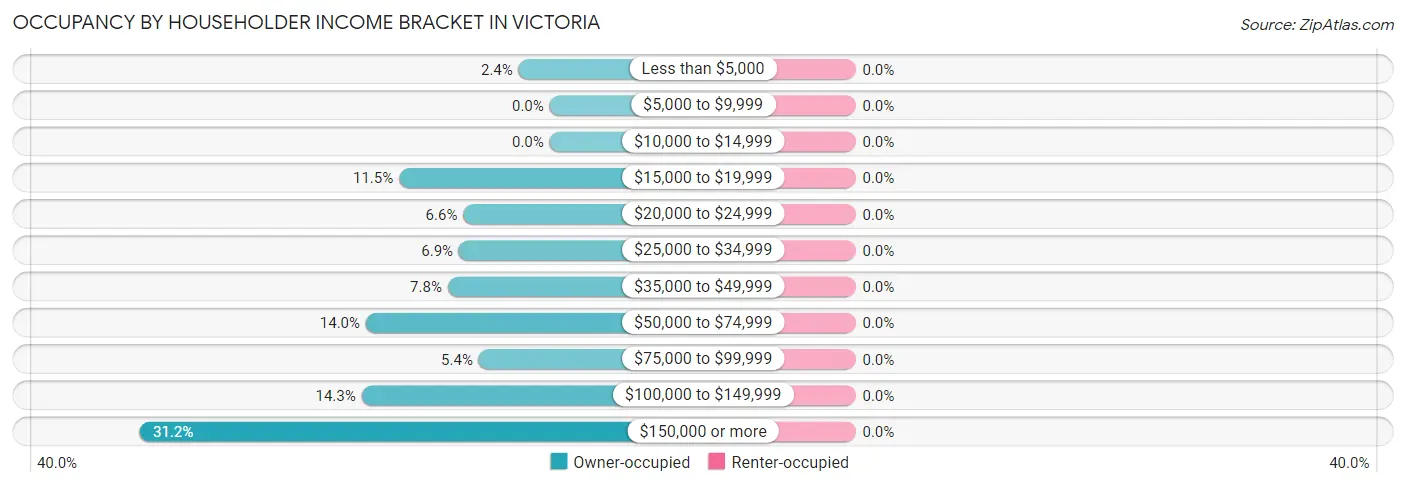
| Income Bracket | Owner-occupied | Renter-occupied |
| Less than $5,000 | 14 (2.4%) | 0 (0.0%) |
| $5,000 to $9,999 | 0 (0.0%) | 0 (0.0%) |
| $10,000 to $14,999 | 0 (0.0%) | 0 (0.0%) |
| $15,000 to $19,999 | 68 (11.5%) | 0 (0.0%) |
| $20,000 to $24,999 | 39 (6.6%) | 0 (0.0%) |
| $25,000 to $34,999 | 41 (6.9%) | 0 (0.0%) |
| $35,000 to $49,999 | 46 (7.8%) | 0 (0.0%) |
| $50,000 to $74,999 | 83 (14.0%) | 0 (0.0%) |
| $75,000 to $99,999 | 32 (5.4%) | 0 (0.0%) |
| $100,000 to $149,999 | 85 (14.3%) | 0 (0.0%) |
| $150,000 or more | 185 (31.2%) | 0 (0.0%) |
| Total | 593 (100.0%) | 0 (0.0%) |
Monthly Housing Cost Tiers in Victoria

| Monthly Cost | Owner-occupied | Renter-occupied |
| Less than $300 | 176 (29.7%) | 0 (0.0%) |
| $300 to $499 | 40 (6.8%) | 0 (0.0%) |
| $500 to $799 | 21 (3.5%) | 0 (0.0%) |
| $800 to $999 | 0 (0.0%) | 0 (0.0%) |
| $1,000 to $1,499 | 240 (40.5%) | 0 (0.0%) |
| $1,500 to $1,999 | 116 (19.6%) | 0 (0.0%) |
| $2,000 to $2,499 | 0 (0.0%) | 0 (0.0%) |
| $2,500 to $2,999 | 0 (0.0%) | 0 (0.0%) |
| $3,000 or more | 0 (0.0%) | 0 (0.0%) |
| Total | 593 (100.0%) | 0 (0.0%) |
Physical Housing Characteristics in Victoria
Housing Structures in Victoria

| Structure Type | # Housing Units | % Housing Units |
| Single Unit, Detached | 346 | 58.4% |
| Single Unit, Attached | 0 | 0.0% |
| 2 Unit Apartments | 0 | 0.0% |
| 3 or 4 Unit Apartments | 0 | 0.0% |
| 5 to 9 Unit Apartments | 0 | 0.0% |
| 10 or more Apartments | 0 | 0.0% |
| Mobile Home / Other | 247 | 41.6% |
| Total | 593 | 100.0% |
Housing Structures by Occupancy in Victoria

| Structure Type | Owner-occupied | Renter-occupied |
| Single Unit, Detached | 346 (100.0%) | 0 (0.0%) |
| Single Unit, Attached | 0 (0.0%) | 0 (0.0%) |
| 2 Unit Apartments | 0 (0.0%) | 0 (0.0%) |
| 3 or 4 Unit Apartments | 0 (0.0%) | 0 (0.0%) |
| 5 to 9 Unit Apartments | 0 (0.0%) | 0 (0.0%) |
| 10 or more Apartments | 0 (0.0%) | 0 (0.0%) |
| Mobile Home / Other | 247 (100.0%) | 0 (0.0%) |
| Total | 593 (100.0%) | 0 (0.0%) |
Housing Structures by Number of Rooms in Victoria

| Number of Rooms | Owner-occupied | Renter-occupied |
| 1 Room | 0 (0.0%) | 0 (0.0%) |
| 2 or 3 Rooms | 0 (0.0%) | 0 (0.0%) |
| 4 or 5 Rooms | 252 (42.5%) | 0 (0.0%) |
| 6 or 7 Rooms | 169 (28.5%) | 0 (0.0%) |
| 8 or more Rooms | 172 (29.0%) | 0 (0.0%) |
| Total | 593 (100.0%) | 0 (0.0%) |
Housing Structure by Heating Type in Victoria

| Heating Type | Owner-occupied | Renter-occupied |
| Utility Gas | 104 (17.5%) | 0 (0.0%) |
| Bottled, Tank, or LP Gas | 161 (27.2%) | 0 (0.0%) |
| Electricity | 275 (46.4%) | 0 (0.0%) |
| Fuel Oil or Kerosene | 0 (0.0%) | 0 (0.0%) |
| Coal or Coke | 0 (0.0%) | 0 (0.0%) |
| All other Fuels | 53 (8.9%) | 0 (0.0%) |
| No Fuel Used | 0 (0.0%) | 0 (0.0%) |
| Total | 593 (100.0%) | 0 (0.0%) |
Household Vehicle Usage in Victoria

| Vehicles per Household | Owner-occupied | Renter-occupied |
| No Vehicle | 21 (3.5%) | 0 (0.0%) |
| 1 Vehicle | 150 (25.3%) | 0 (0.0%) |
| 2 Vehicles | 193 (32.6%) | 0 (0.0%) |
| 3 or more Vehicles | 229 (38.6%) | 0 (0.0%) |
| Total | 593 (100.0%) | 0 (0.0%) |
Real Estate & Mortgages in Victoria
Real Estate and Mortgage Overview in Victoria
| Characteristic | Without Mortgage | With Mortgage |
| Housing Units | 269 | 324 |
| Median Property Value | - | - |
| Median Household Income | $27,852 | $168 |
| Monthly Housing Costs | $243 | $0 |
| Real Estate Taxes | $418 | $0 |
Property Value by Mortgage Status in Victoria

| Property Value | Without Mortgage | With Mortgage |
| Less than $50,000 | 121 (45.0%) | 0 (0.0%) |
| $50,000 to $99,999 | 27 (10.0%) | 32 (9.9%) |
| $100,000 to $299,999 | 121 (45.0%) | 178 (54.9%) |
| $300,000 to $499,999 | 0 (0.0%) | 0 (0.0%) |
| $500,000 to $749,999 | 0 (0.0%) | 0 (0.0%) |
| $750,000 to $999,999 | 0 (0.0%) | 0 (0.0%) |
| $1,000,000 or more | 0 (0.0%) | 114 (35.2%) |
| Total | 269 (100.0%) | 324 (100.0%) |
Household Income by Mortgage Status in Victoria

| Household Income | Without Mortgage | With Mortgage |
| Less than $10,000 | 14 (5.2%) | 0 (0.0%) |
| $10,000 to $24,999 | 107 (39.8%) | 0 (0.0%) |
| $25,000 to $34,999 | 41 (15.2%) | 0 (0.0%) |
| $35,000 to $49,999 | 46 (17.1%) | 0 (0.0%) |
| $50,000 to $74,999 | 44 (16.4%) | 0 (0.0%) |
| $75,000 to $99,999 | 0 (0.0%) | 39 (12.0%) |
| $100,000 to $149,999 | 0 (0.0%) | 32 (9.9%) |
| $150,000 or more | 17 (6.3%) | 85 (26.2%) |
| Total | 269 (100.0%) | 324 (100.0%) |
Property Value to Household Income Ratio in Victoria

| Value-to-Income Ratio | Without Mortgage | With Mortgage |
| Less than 2.0x | 138 (51.3%) | 162,984 (50,303.7%) |
| 2.0x to 2.9x | 46 (17.1%) | 171 (52.8%) |
| 3.0x to 3.9x | 32 (11.9%) | 39 (12.0%) |
| 4.0x or more | 53 (19.7%) | 0 (0.0%) |
| Total | 269 (100.0%) | 324 (100.0%) |
Real Estate Taxes by Mortgage Status in Victoria

| Property Taxes | Without Mortgage | With Mortgage |
| Less than $800 | 118 (43.9%) | 0 (0.0%) |
| $800 to $1,499 | 21 (7.8%) | 0 (0.0%) |
| $800 to $1,499 | 17 (6.3%) | 210 (64.8%) |
| Total | 269 (100.0%) | 324 (100.0%) |
Health & Disability in Victoria
Health Insurance Coverage by Age in Victoria

| Age Bracket | With Coverage | Without Coverage |
| Under 6 Years | 0 (0.0%) | 0 (0.0%) |
| 6 to 18 Years | 142 (100.0%) | 0 (0.0%) |
| 19 to 25 Years | 77 (100.0%) | 0 (0.0%) |
| 26 to 34 Years | 84 (100.0%) | 0 (0.0%) |
| 35 to 44 Years | 207 (100.0%) | 0 (0.0%) |
| 45 to 54 Years | 293 (100.0%) | 0 (0.0%) |
| 55 to 64 Years | 145 (100.0%) | 0 (0.0%) |
| 65 to 74 Years | 156 (100.0%) | 0 (0.0%) |
| 75 Years and older | 141 (100.0%) | 0 (0.0%) |
| Total | 1,245 (100.0%) | 0 (0.0%) |
Health Insurance Coverage by Citizenship Status in Victoria

| Citizenship Status | With Coverage | Without Coverage |
| Native Born | 0 (0.0%) | 0 (0.0%) |
| Foreign Born, Citizen | 142 (100.0%) | 0 (0.0%) |
| Foreign Born, not a Citizen | 77 (100.0%) | 0 (0.0%) |
Health Insurance Coverage by Household Income in Victoria

| Household Income | With Coverage | Without Coverage |
| Under $25,000 | 175 (100.0%) | 0 (0.0%) |
| $25,000 to $49,999 | 128 (100.0%) | 0 (0.0%) |
| $50,000 to $74,999 | 211 (100.0%) | 0 (0.0%) |
| $75,000 to $99,999 | 160 (100.0%) | 0 (0.0%) |
| $100,000 and over | 571 (100.0%) | 0 (0.0%) |
Public vs Private Health Insurance Coverage by Age in Victoria

| Age Bracket | Public Insurance | Private Insurance |
| Under 6 | 0 (0.0%) | 0 (0.0%) |
| 6 to 18 Years | 86 (60.6%) | 56 (39.4%) |
| 19 to 25 Years | 0 (0.0%) | 77 (100.0%) |
| 25 to 34 Years | 0 (0.0%) | 84 (100.0%) |
| 35 to 44 Years | 0 (0.0%) | 207 (100.0%) |
| 45 to 54 Years | 0 (0.0%) | 293 (100.0%) |
| 55 to 64 Years | 33 (22.8%) | 127 (87.6%) |
| 65 to 74 Years | 156 (100.0%) | 97 (62.2%) |
| 75 Years and over | 141 (100.0%) | 36 (25.5%) |
| Total | 416 (33.4%) | 977 (78.5%) |
Disability Status by Sex by Age in Victoria

| Age Bracket | Male | Female |
| Under 5 Years | 0 (0.0%) | 0 (0.0%) |
| 5 to 17 Years | 0 (0.0%) | 0 (0.0%) |
| 18 to 34 Years | 0 (0.0%) | 0 (0.0%) |
| 35 to 64 Years | 24 (6.1%) | 39 (15.7%) |
| 65 to 74 Years | 29 (51.8%) | 56 (56.0%) |
| 75 Years and over | 37 (100.0%) | 104 (100.0%) |
Disability Class by Sex by Age in Victoria
Disability Class: Hearing Difficulty

| Age Bracket | Male | Female |
| Under 5 Years | 0 (0.0%) | 0 (0.0%) |
| 5 to 17 Years | 0 (0.0%) | 0 (0.0%) |
| 18 to 34 Years | 0 (0.0%) | 0 (0.0%) |
| 35 to 64 Years | 9 (2.3%) | 0 (0.0%) |
| 65 to 74 Years | 21 (37.5%) | 0 (0.0%) |
| 75 Years and over | 19 (51.3%) | 19 (18.3%) |
Disability Class: Vision Difficulty

| Age Bracket | Male | Female |
| Under 5 Years | 0 (0.0%) | 0 (0.0%) |
| 5 to 17 Years | 0 (0.0%) | 0 (0.0%) |
| 18 to 34 Years | 0 (0.0%) | 0 (0.0%) |
| 35 to 64 Years | 9 (2.3%) | 0 (0.0%) |
| 65 to 74 Years | 8 (14.3%) | 0 (0.0%) |
| 75 Years and over | 0 (0.0%) | 0 (0.0%) |
Disability Class: Cognitive Difficulty

| Age Bracket | Male | Female |
| 5 to 17 Years | 0 (0.0%) | 0 (0.0%) |
| 18 to 34 Years | 0 (0.0%) | 0 (0.0%) |
| 35 to 64 Years | 9 (2.3%) | 0 (0.0%) |
| 65 to 74 Years | 29 (51.8%) | 24 (24.0%) |
| 75 Years and over | 0 (0.0%) | 0 (0.0%) |
Disability Class: Ambulatory Difficulty

| Age Bracket | Male | Female |
| 5 to 17 Years | 0 (0.0%) | 0 (0.0%) |
| 18 to 34 Years | 0 (0.0%) | 0 (0.0%) |
| 35 to 64 Years | 9 (2.3%) | 9 (3.6%) |
| 65 to 74 Years | 21 (37.5%) | 56 (56.0%) |
| 75 Years and over | 18 (48.6%) | 85 (81.7%) |
Disability Class: Self-Care Difficulty

| Age Bracket | Male | Female |
| 5 to 17 Years | 0 (0.0%) | 0 (0.0%) |
| 18 to 34 Years | 0 (0.0%) | 0 (0.0%) |
| 35 to 64 Years | 9 (2.3%) | 0 (0.0%) |
| 65 to 74 Years | 21 (37.5%) | 24 (24.0%) |
| 75 Years and over | 0 (0.0%) | 17 (16.4%) |
Technology Access in Victoria
Computing Device Access in Victoria

| Device Type | # Households | % Households |
| Desktop or Laptop | 378 | 63.7% |
| Smartphone | 423 | 71.3% |
| Tablet | 212 | 35.7% |
| No Computing Device | 126 | 21.2% |
| Total | 593 | 100.0% |
Internet Access in Victoria

| Internet Type | # Households | % Households |
| Dial-Up Internet | 0 | 0.0% |
| Broadband Home | 197 | 33.2% |
| Cellular Data Only | 83 | 14.0% |
| Satellite Internet | 14 | 2.4% |
| No Internet | 135 | 22.8% |
| Total | 593 | 100.0% |
Common Questions
What is Per Capita Income in Victoria?
Per Capita income in Victoria is $59,065.
What is the Median Household income in Victoria?
Median Household Income in Victoria is $92,930.
What is Inequality or Gini Index in Victoria?
Inequality or Gini Index in Victoria is 0.54.
What is the Total Population of Victoria?
Total Population of Victoria is 1,245.
What is the Total Male Population of Victoria?
Total Male Population of Victoria is 668.
What is the Total Female Population of Victoria?
Total Female Population of Victoria is 577.
What is the Ratio of Males per 100 Females in Victoria?
There are 115.77 Males per 100 Females in Victoria.
What is the Ratio of Females per 100 Males in Victoria?
There are 86.38 Females per 100 Males in Victoria.
What is the Median Population Age in Victoria?
Median Population Age in Victoria is 47.0 Years.
What is the Average Family Size in Victoria
Average Family Size in Victoria is 2.7 People.
What is the Average Household Size in Victoria
Average Household Size in Victoria is 2.1 People.
How Large is the Labor Force in Victoria?
There are 667 People in the Labor Forcein in Victoria.
What is the Percentage of People in the Labor Force in Victoria?
58.5% of People are in the Labor Force in Victoria.